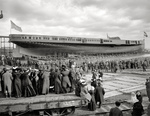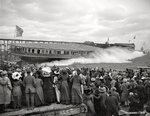Wolverine
| Country | United States |
| Hull Number | IX-64 |
| Builder | American Ship Building Company, Wyandotte, Michigan, United States |
| Commission Date | 12 Aug 1942 |
| Decommission Date | 7 Nov 1945 |
| Displacement | 7,300 tons standard |
| Length | 500 feet |
| Beam | 98 feet |
| Draft | 15 feet |
| Machinery | 4 coal-fired boilers, reciprocating steam engines producing 8,000hp |
| Speed | 18 knots |
| Crew | 270 |
Contributor: David Stubblebine
ww2dbaseUSS Wolverine (IX-64) was a fresh water aircraft carrier of the United States Navy during World War II used to offer advanced training for naval aviators in carrier take-offs and landings. She was converted from a coal-burning a side-wheel Great Lakes excursion steamer built in 1912. Originally named Seeandbee, a name based upon her owners' company name, the Cleveland and Buffalo Transit Co., she was built by the American Ship Building Company of Wyandotte, Michigan, United States. The Navy acquired the sidewheeler on 12 March 1942 and designated her as an unclassified miscellaneous auxiliary, IX-64. Intended to operate on Lake Michigan, the ship received the new name Wolverine because the state of Michigan is known as the Wolverine State. The name Wolverine was approved on 2 August 1942 with the ship being commissioned ten days later.
ww2dbaseKey to her mission was the 550 ft flight deck that she received. Wolverine began her new job in January 1943; the Navy's other sidewheeler training carrier, USS Sable (IX-81), joined Wolverine in May.
ww2dbaseIn conjunction with NAS Glenview, the two paddle-wheelers offered critical training in basic carrier operations to thousands of pilots and a smaller number of Landing Signal Officers (LSOs). Wolverine and Sable enabled the pilots and LSOs to learn to handle take-offs and landings on a real flight deck. The Great Lakes sidewheelers were a far cry from front-line carriers, but they accomplished the Navy's purpose: qualifying naval aviators fresh out of operational flight training in carrier landings.
ww2dbaseBecause Wolverine and Sable were not combat carriers, they had many limitations. One was that they had no elevators or hangar decks. When pilots used up the allotted spots on the flight deck for parking their aircraft, the day's operations were over and the carriers headed back to their pier in Chicago, Illinois, United States.
ww2dbaseAnother problem the two carriers had to contend with was their inability to produce wind over the deck (WOD) due to their slow top speeds. The Navy’s front line aircraft of the day required certain minimum levels of WOD in order to land or take off. When there was little or no wind on Lake Michigan, operations often had to be curtailed because the carriers couldn’t generate sufficient speed to meet the WOD minimums.
ww2dbaseOccasionally, when low-wind conditions persisted for several days and the pool of waiting aviators started to bunch up, the Navy turned to an alternate system of qualifications. The pilots qualified in SNJ Texan aircraft - even though most pilots had last flown the SNJ four or five months earlier.
ww2dbaseOnce the war was over, the need for such training ships also came to an end. The Navy decommissioned Wolverine on 7 November 1945; three weeks later, on 28 November, she was struck from the Naval Vessel Register. Wolverine was then transferred to the Maritime Commission on 26 November 1947 for disposal. The last records indicate that the ship was sold for scrapping in December 1947.
ww2dbaseTogether, Wolverine and Sable trained 17,820 pilots in 116,000 carrier landings. Of these, 65,000 landings were on Wolverine alone. Of the estimated 135–300 aircraft lost during training, 35 have been salvaged and the search for more is underway.
ww2dbaseSource: Wikipedia.
Last Major Revision: Dec 2013
Wolverine (IX-64) Interactive Map
Photographs
 |  |  |  |
Wolverine Operational Timeline
| 2 Mar 1942 | US Navy acquired excursion steamer Seeandbee. |
| 2 Aug 1942 | US Navy approved the new name Wolverine for the fresh water aircraft carrier recently converted from excursion steamer Seeandbee. |
| 12 Aug 1942 | USS Wolverine was commissioned into service with Commander George Richardson Fairlamb, Jr. in command. |
| 7 Nov 1945 | USS Wolverine was decommissioned from service. |
| 28 Nov 1945 | Wolverine was struck from the US Naval Vessel Register. |
| 26 Nov 1947 | Wolverine was transferred to the Maritime Commission for disposal. |
Please consider supporting us on Patreon. Even $1 per month will go a long way! Thank you. Please help us spread the word: Stay updated with WW2DB: |

- » Wreck of Teruzuki Found (27 Jul 2025)
- » USS Orlean's Bow Found (22 Jul 2025)
- » The Emperor of Japan Planned to Honor WW2-era Japanese POWs in Mongolia (4 Jul 2025)
- » US State Lawmaker John Winter Caught Using Racial Slur "Jap" and Apologized (11 Jun 2025)
- » US Government Plans to Purge WW2 Information (17 Mar 2025)
- » See all news
- » 1,181 biographies
- » 337 events
- » 45,111 timeline entries
- » 1,247 ships
- » 350 aircraft models
- » 207 vehicle models
- » 376 weapon models
- » 123 historical documents
- » 261 facilities
- » 470 book reviews
- » 28,470 photos
- » 365 maps
Winston Churchill
Please consider supporting us on Patreon. Even $1 a month will go a long way. Thank you!
Or, please support us by purchasing some WW2DB merchandise at TeeSpring, Thank you!